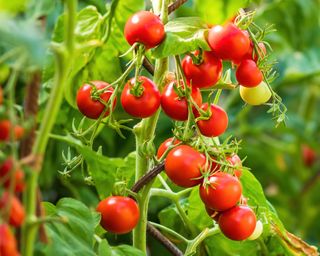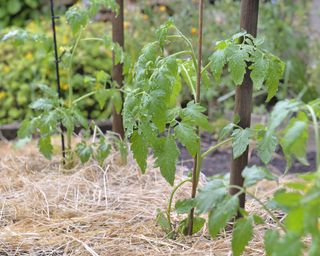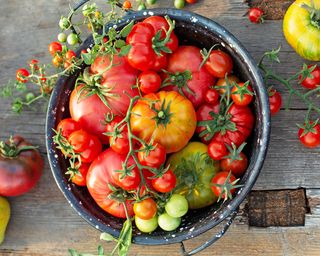Sweet, juicy tomatoes right from the garden are a summertime treat, so it’s only natural to want to start enjoying your home-grown bounty as soon as possible. However, as it takes up to 90 days to get fruit on plants started from seed, knowing how to make tomato plants grow faster is essential for an early harvest.
In addition, the summer heat doesn’t last the same amount of time in different regions. While southern gardeners benefit from a long summer, gardeners in northern climates know the importance of accelerating the growth of their plants. Growing tomatoes presents a challenge as they are warm-season plants that need enough time to mature and produce fruit.
In cooler regions, this means the plant must be started indoors or a start must be purchased. There are a few tricks to getting the plant’s growth to speed up, but there are a couple of downsides to consider.
Benefits Of Speeding Up Tomato Growth
In the US, the south has a significantly longer warm period than the north. In the south, plants may be set out much earlier due to a shorter freeze period, while the northern gardener must wait until May on average to plant their tomatoes outdoors. That doesn’t leave much time for the plant to mature and provide fruit.
Encouraging the growth of the plant helps ensure plenty of fruit in colder climates where a killing frost may occur as early as September.
In addition, gardeners in warmer regions who have left it a little late to start their tomatoes may be able to plant later than usual.
(Image credit: Shutterstock)
Cons To Accelerating Tomato Growth
The negative effects of speeding growth in any plant can also occur. Encouraging a plant to grow too rapidly may cause it to become leggy. Spindly plants produce fewer side shoots and therefore less fruiting spurs.
Forcing rapid vegetative growth can diminish the fruit, which is the whole reason for growing the plant.
In seedlings, over-fertilizing directs energy to the vegetative growth because the plant is not mature enough to begin budding. This creates a slender, tall plant that is not strong.
Even plants that have many pairs of true leaves could be forced to fruit with certain fertilizer formulas. However, early fruiting in plants that are not sturdy enough to hold the water-laden fruits can cause stem breakage.
Tips On Making Tomato Plants Grow Faster
You can encourage faster growth in a tomato plant, but it should be done slowly. The outstanding benefits of some of these practices will be outweighed if the growth is too rapid.
Bear in mind that site selection is key. Make sure the plant is in full sun where it will get at least eight hours or more of sun.

(Image credit: Shutterstock)
1. Select An Early Season Variety
Many tomato varieties will produce fruit earlier in the season. Choosing cherry tomatoes is ideal because they produce fruit in just a couple of months.
For larger tomatoes, try Early Cascade, Kootenai, Gold Nugget, Early Spring, Fantastic Hybrid, Pic Red, and other cultivars that bloom and fruit quickly.
2. Start Them As Early As Possible
Start tomatoes indoors eight weeks before the date of the last frost. This will give seedlings time to get big enough for outdoor transplanting.
Make sure to harden off seedlings so they can adjust to outdoor weather, wind, and other conditions. Indoor plants can also be babied more so they have more rapid growth than those started outside.
3. Plant Them In A Raised Bed
A raised bed warms much more quickly than garden soil. It will also allow you to control the soil composition. Better soil means quicker growth.
A mixture of shale, compost, and manure, with soft rock phosphate, alfalfa meal, and worm castings is a “super soil” for tomato growth. There are also bags of purchased soil mixes especially made for tomatoes.

(Image credit: Getty Images)
4. Use A Water Wall
If a raised bed isn’t available, protect seedlings from wind and keep them warm with a water wall. These are inexpensive, reusable pocketed structures. They go around the plant and then each cell is filled with water.
Before the plant gets too big and once ambient temperatures are consistently warm, remove the water wall.
5. Add Mulch To Warm The Soil
Once the plant is established outdoors, mulch tomatoes using plastic, straw, or other material around the root zone. Some gardeners swear by red plastic sheeting, but in my experience, it makes no difference.
Cedar shavings are great because they have pest-repellent properties that can warm off tomato pests. Straw is also an excellent mulch, but avoid hay as it contains seeds. Using organic mulch has other benefits as it slowly rots into the soil, providing nutrients.

(Image credit: Getty Images)
6. Prune Your Plants
Pruning tomato plants doesn’t mean going in with pruners and lopping off stems. Tomato pruning in indeterminate varieties increases growth and fruit production. This is because you are removing strictly vegetative growth. Taking off that growth encourages energy to produce blooms and fruit. It also reduces disease by increasing airflow in the plant’s interior.
By early July, begin pruning off suckers. These are at the leaf axils and can be easily pinched off. Remove each sucker on the plant – except the first one below the lowest flower. This should be left to grow on and bear fruit.
7. Fertilize Tomatoes – But Not Too Much
A word on fertilizing tomatoes to spur growth. Young seedlings can only grow just so quickly because their root systems are not extensive. So do fertilize them, but avoid high ratios.
Use a gentle compost tea, fish emulsion, or kelp on young plants. Then, about a month after planting outside, feed the tomato with a nitrogen formula.
Established plants should not be fed with high-nitrogen food. This will concentrate all the energy into vegetative growth, instead of fruits. Phosphorus formulas can direct fruit production and the nitrogen necessary can come from well-rotted manure or compost, side-dressed around the plant.
There are many tomato formulas available for purchase. Choose a ratio of 5-10-5 for maximum fruit production, or make your own homemade tomato fertilizer.




